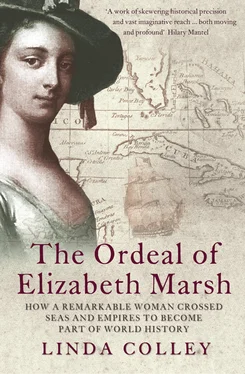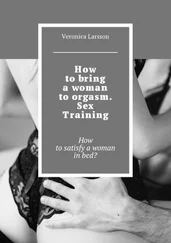Many Africans caught up in the slave trade perished long before they arrived at Jamaica. They were killed resisting capture, or they died of shipborne diseases, or they committed suicide in order to escape the pain and humiliation of servitude, or out of a belief that death would restore their spirits to their homelands. Of those who reached the island and stayed there, as distinct from being re-exported to Spanish America or the Dutch West Indies, perhaps half died in the first two or three years, that apprentice phase of slavery which local whites termed ‘the seasoning’. And few Jamaicans, black or white, slave or free, survived on the island for longer than fifteen years. 11
Milbourne Marsh and the other men on the Kingston saw their first ‘guineaman come in with slaves’ to Port Royal harbour shortly after their own arrival. Captain Thomas Trevor was so struck by the sight, and by the sounds coming from those on board the slave-ship, that he made a special note of the event in his logbook. 12 It was an act that marked him out as a newcomer to the Caribbean; and neither he nor most of his fellow seamen on the Kingston were in a position to understand that slave ships might be lethal even to those who were not imprisoned on board. Jamaica’s heavy rains and malarial swamps killed easily enough, and new arrivals were particularly vulnerable. They were still more so if they made landfall – as the crew of the Kingston did – during the rainy summer months:
New-come buckra,
He get sick,
He tak fever,
He be die
He be die. 13
Slave ships transported in still further risks. They often carried smallpox, and in their water casks and cisterns they also brought in the West African mosquitoes that spread yellow fever. Once in port, the insects would seek out fresh human hosts, and places in which to breed. New immigrants with no immunity were easy targets, and so were men crowded together in damp wooden ships equipped with their own water barrels.
The 327 seamen aboard the Kingston had remained healthy on the three-month voyage out from Portsmouth, but this changed once they were exposed to Jamaica’s infection, climate, and the appalling sanitation of Port Royal and Kingston. Two weeks after its arrival, the ship was already ‘growing bad’ and losing men. The mortality rate lessened once it started patrolling the Caribbean, only to increase when it moored off Jamaica’s other naval base, Port Antonio, on the north-eastern coast of the island, a place at this time of ‘prodigious rains … insomuch that sometimes for several months together, there is hardly one fair or dry day in a week between’. For some weeks in early 1733, the Kingston was unable to put out to sea. Many of the original crewmen had died, and some of the survivors were too weak for the heavy manual labour and agility demanded by a wooden ship of war. 14 And this was when the man called Milbourne Marsh began to show his quality.
He had come to Jamaica knowing something of the risks. Six years before the Kingston’s voyage, in 1726, Rear-Admiral Francis Hosier had led a naval squadron of 4750 men out of Portsmouth to intercept Spanish treasure ships in the West Indies. Yellow fever killed him in Jamaica within a year, along with four thousand of his men. 15 British newspapers, folk tales and ballads ensured that this disaster was widely known, especially in Milbourne’s home town of Portsmouth, so joining a ship bound for the Caribbean was a calculated gamble on his part. In 1732 he was twenty-two and single, with no formal education or means of support except his own skills. The Kingston , with its sixty guns, was the flagship of Commodore Richard Lestock, who would soon be replaced by Admiral Sir Chaloner Ogle. Joining it as a carpenter’s mate gave Milbourne more wages and status than were available on voyages and in shipyards nearer home, a chance of attracting the attention of influential patrons in the navy, and passage to a frontier society where poor whites could sometimes encounter greater opportunities, if they survived.
That Milbourne Marsh did so, and lived to father Elizabeth Marsh, was a function not simply of luck, but also of his persistent intelligence and confidence, and his specific skills. A carpenter aboard a Royal Navy warship was a warrant sea officer. Like his fellow warrant officers, the gunner and the boatswain, he was not regarded – as fighting sea officers usually were – as a gentleman. Ships’ carpenters were not granted a formal navy uniform until the end of the eighteenth century, and they did not expect to dine at the captain’s table or in the wardroom. They were specialist craftsmen with a distinctive role aboard ship, and a recognized status. Even a carpenter’s mate was treated as roughly on a par with a midshipman, the apprentice rank for commissioned officers. ‘The carpenter’, declared the navy’s printed regulations at this time:
is to take upon himself the care and preservation of the ship’s hull, masts, yards, bulkheads, and cabins, etc and to receive into his charge the sea stores committed to him by indenture from the Surveyor of the Navy. At sea, he is to visit daily all the parts of the ship, and see if the ports are well secured, and decks and sides be well caulked, and whether any thing gives way; and if the pumps are in good order; and from time to time to inspect into the condition of the masts and yards, and to make a report of every thing to the Captain. 16
The ability to carry out these duties efficiently was especially valued in the Caribbean. Even after hulls began to be sheathed in copper, wooden ships rarely lasted in these warm, stormy, worm-ridden waters for more than three years, and constant maintenance was required to keep them seaworthy even for this long. Consequently, Milbourne Marsh’s skills assured him a particular status here, and he seems consciously to have exploited this in order to advance and stay alive. In January 1733 he abandoned the fever-stricken Kingston to replace a dead man as ship’s carpenter on the Deal Castle . The move increased his workload, since this new vessel was a modest twenty-four-gun frigate with a smaller crew to share the tasks of maintenance and sailing, but it gained him promotion, higher wages, and for a while a healthier working environment. In August, when crewmen were being taken off the Deal Castle to join an expedition against rebel slaves, Milbourne promptly switched ships again, moving this time to be carpenter of the Rupert , a veteran 930-ton warship with a crew of 350. 17
Unlike most men at sea, a ship’s carpenter was not woken up every four hours at night to stand watch. Nor did he usually have to snap to attention when ‘All hands on deck’ was piped. So although his was an arduous, often dangerous job, frequently carried out in the rigging fifty to seventy feet above deck, Milbourne Marsh experienced a better working life off Jamaica than many of his comrades. He was more rested and less stressed, and he would have been buoyed up by a consciousness of his modest indispensability. Once on the Rupert , he spent most of the next nineteen months at sea, and therefore less at risk of disease, but never straying out of the Caribbean, and returning at regular intervals to Port Royal, something that had begun to be important.
The name she went by was Elizabeth Evans, and he claimed later that she was about one year younger than himself. She had been an Elizabeth Bouchier, and living as a single woman in Port Royal, when she met and married James Evans in 1728. 18 Evans was another migrant, possibly Pennsylvanian by origin, and worked part-time as a shipwright on the Royal Navy vessels anchoring off the port. Milbourne Marsh and Elizabeth Evans appear to have known each other well before August 1734, because it was in this month that Evans made his will. For a man of his sort, this was an atypical act. Since death snatched Jamaicans so quickly, most died intestate; and white craftsmen and artisans only occasionally went to the expense of setting out their final dispensations and opinions in legal script. Evans, though, whose signature on the will, and the ‘few old books’ he left behind, reveal a certain level of literacy, chose to have this final say, this last exercise of power. Mindful of the ‘peril & dangers of the sea and other uncertainties of this transitory life’, he declared, he wanted to make his wishes known ‘for the sake of avoiding controversies after my decease’. 19 As well as these formulaic pieties, he also had something substantial to leave; and someone, and perhaps two people, to accuse.
Читать дальше












